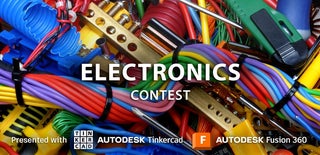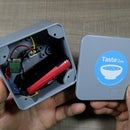Introduction: Play Button Award From Old Computer Motherboard
I'm very far from receiving an original play button award from Google so while waiting on it, I decided that I will build my own version as a prop for my studio.
Since my channel is based around electronics, it came naturally that the button is made out of PCB.
Since I didn't want to waste any new PCBs, I used an old computer motherboard and made the button from it.
If you need to manufacture PCBs for your projects, PCBWay offers great services at really low prices.
Supplies
Tools and materials used in the video:
- Heat gun: https://s.click.aliexpress.com/e/_A7KXBB
- Mini vise: https://s.click.aliexpress.com/e/_AYajjP
- Needle nose pliers: https://s.click.aliexpress.com/e/_ArzTpb
- Screwdriver set: https://s.click.aliexpress.com/e/_A3i6pf
- Hack saw: https://s.click.aliexpress.com/e/_A0b8X7
- Belt sander: https://s.click.aliexpress.com/e/_9jmSMd
- Metal file: https://s.click.aliexpress.com/e/_9iwPjn
- Picture frame: https://s.click.aliexpress.com/e/_9GGjvx
- Flashing LEDs: https://s.click.aliexpress.com/e/_AK8ZDb
- Power bank module: https://s.click.aliexpress.com/e/_9vQTal
- Mini switch: https://s.click.aliexpress.com/e/_AqFBqz
- 18650 battery: https://s.click.aliexpress.com/e/_AfjgVB
- Soldering station: https://s.click.aliexpress.com/e/_AkDpgt
- Hot glue gun: https://s.click.aliexpress.com/e/_AY0kG9
Step 1: Remove the Components From the Motherboard
I started by first removing the components that were attached with clips or screws, and I then used my heat gun on a high setting to start and heat up the board from the back.
Once the board started to heat up and the solder melted, I used a pair of pliers to gently grab the components and pull them out one by one.
This is a relatively easy and fast process, but you need to keep in mind that both the PCB and the components will be hot for some time after you remove them so be extra careful not to burn yourself.
Additionally, some of the plastics or the PCB may release some fumes so do this outside or in a well-ventilated area.
You can keep some of the removed components and connectors for other projects.
Step 2: Cut Out the Play Button Shape
I print out a template of the play button and I then transferred the design to an area of the motherboard that I liked the most.
The button is relatively small compared to the PCB so you can choose to use any area that you like or even make several buttons from just one motherboard.
If you have some leftovers from the board, you can also make some keyrings as I made previously.
The board is easy to cut with a hack saw or just a coping saw.
Step 3: Refine the Play Button Edges
Since the cut PCB was rough, I mounted my belt sander upside down and I sanded the play button to the line that I marked previously.
Obviously, this step can also be done by hand, but using a powered tool makes the whole process much faster.
Also, make sure to have dust collection set up as the fiberboard of the PCB is not something that you want to breathe in.
To smooth out the inner hole, I used a small metal file to remove any extra material left from cutting it.
Step 4: Prepare the Picture Frame
To house the entire project, I bought a picture frame that had deep sides. This is important as once we mount the play button it will stick out so there needs to be enough space inside the frame to house it.
Since I did not need the original picture mounting cardboard, I first removed the back and removed all of the cardboard from the frame.
To make a nice base for the play button, I used a matt black spray paint to paint the back cover of the frame and the play button will be mounted directly to it.
Step 5: Prepare the Flashing LEDs
Since every project is better with flashing lights, I glued 4 color-changing LEDs on the back of the play button and I then used small wires to connect them all in parallel.
When gluing, I made sure to orient them in a circle so the light flows around the play button later on.
Step 6: Prepare the Power Bank Module
The LEDs will be powered by a single 18650 lithium cell that will be connected to a power bank module.
The module will provide us with a way to protect the battery from under-voltage but it will also allow us an easy way to charge the battery once needed.
Since the play button will later be directly soldered to the output of the board, the USB port will be free to be used as an emergency power bank or as a power source for additional props around it.
The battery is salvaged from old laptop batteries and when I removed it, I left pieces of the nickel strip attached to it so I can now solder to them, instead of soldering on the battery directly.
Step 7: Attach the Play Button to the Frame Backing
To mount the play button to the frame back, I've used plastic PCB standoffs that have an adhesive back.
The PCB mounts are glued with hot glue to the play button and then, their adhesive is used to stick the play button to the back of the picture frame.
Before attaching it thou, I made a small hole behind the button so the wires for the LEDs can pass to the back side of the frame.
To hole the back in place in the new depth of the frame, I made 4 small holes in the picture frame and I used small metal strips to press them back in place.
Step 8: Connect and Secure the Electronics
Finally, it was time that I solder the wires from the play button to the power bank module and I also added a switch before the play button.
I used hot glue to attach everything to the back and with that, the play button was now complete.
Step 9: Enjoy!
The final piece just blew my mind with how it came out.
During the day the LEDs on the back are subtle but they came to life once it starts to get dark.
The power bank feature comes really handy to also power on the subscriber counter that I made so in combination, they are perfect backdrop props for my videos.
If you are not into making YouTube videos, then you can use the same technique to make custom signs or logos that will look awesome.
I hope that you liked this one, so I'll ask you to subscribe to my YouTube channel and also check out some of my other Instructables.

Participated in the
Electronics Contest













